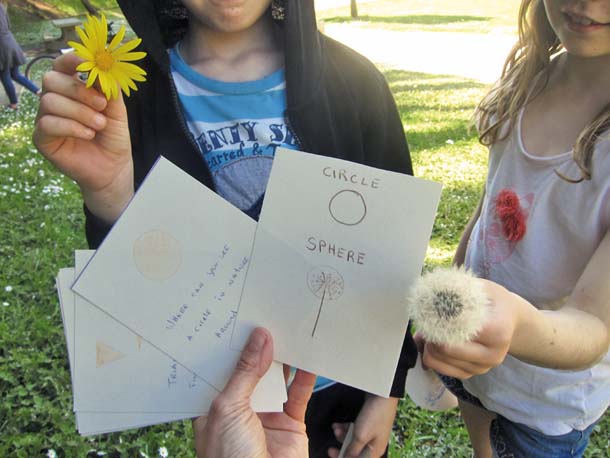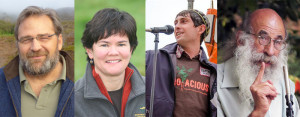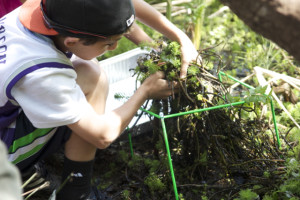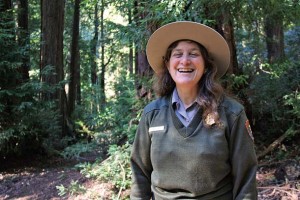Walk any Bay Area trail and your kids might marvel at the views, the wildlife, or the gurgling of a creek–but the variety of geometrical shapes? That takes a junior nerd or somebody interested in making abstract classroom ideas concrete.
I took my girls and three of their friends to a park in Pacifica to help them find and understand geometric concepts in nature. Standing in a meadow by a creek, I asked them to find circles. Inspired by the book Sir Cumference and the First Round Table, we started with a tree stump. Crammed around it, we confirmed it was a circle. Then I said, “Now take 10 steps back and tell me what you see.” They yelled, “An oval!” Enter the concepts of angles and perspective. For a 3-d riff on circles, they hunted dandelions and had a blast blowing away the seeds of dandelion heads.
Kids start learning shapes as soon as they notice the world around them, and there’s no better library of shapes than a wild place like a forest full of leaves, a creek full of stones, or a beach strewn with driftwood. From simple shapes to fractals and Fibonacci sequences, nature can be a geometry playground.
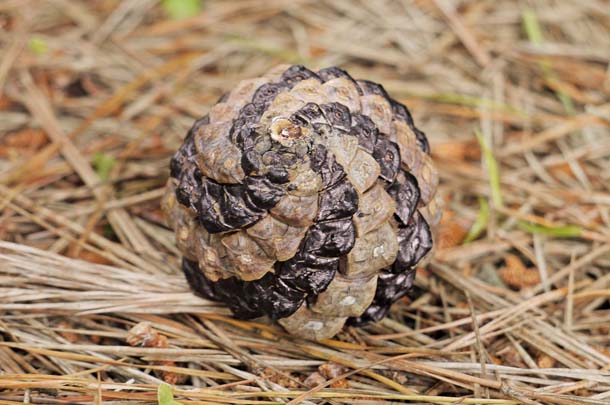
In the Presidio, Katherine Coleman of Caring Creatives takes preschoolers on after-school educational hikes. “For kids, geometry is always abstract and nature quests are a great way to look at concepts and understand sequences,” she says. Her young learners look for triangles, stars, pentagons, or hexagons in eucalyptus seed pods and then count the pods to learn numbers.
Other teachers use nature’s geometry for artistic purposes. “Nature is made of patterns and geometrical shapes,” says Lee McCaffree, instructor and curriculum developer of the Filoli Botanical Art Certificate Program. Noticing shapes is the first step toward drawing those shapes and seeing other patterns too. Look at the base of a pinecone and follow each spiral from the base with a color marker. You’ll notice two sets of spirals. These spirals aren’t random. They’re determined by a number series called the Fibonacci sequence, which starts with 0 and 1, then adds the last two numbers to get the next one (0,1,1,2,3,5…). The same pattern appears in sunflower heads and snail shells.
For Stanford education professor Shelley Goldman, looking for geometry in nature gets kids outdoors and helps them visualize ideas. “A lot of geometry concepts show up at school, but kids don’t go into a garden and look at a flower with a spiral,” she says. Kids can easily understand symmetry by looking at leaves or the reflection of a landscape in water, or hexagons in honeycombs and turtle shells. Any nature hike can become a geometric scavenger hunt.
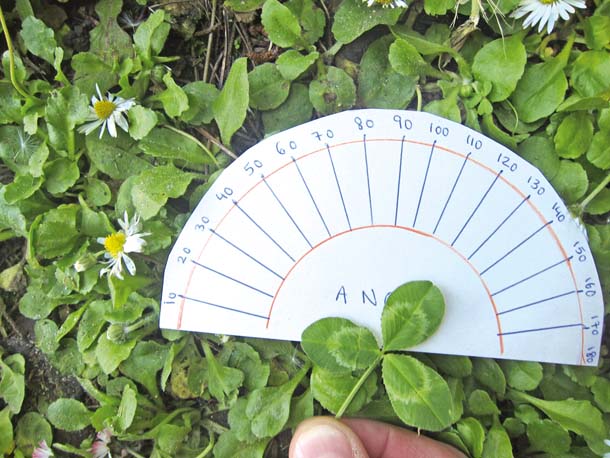
Back in Pacifica, I wanted to show the kids, ranging from preschool to third grade, how angles work using a tree and a branch as lines. We stepped back to where the branch and trunk roughly converged with the center of our homemade protractor and I eyeballed the angle. Voila: 30 degrees! Unimpressed, the kids just stared–30 degrees, so what?
I had to think about everyday examples of angles. A 30-degree angle is a gentle sand dune whose sides you can slide on. A 70-degree angle is a tall boulder you can climb with your hands. A 90-degree angle is a redwood shooting straight up. A 120-degree angle is what separates each stem of a three-leaf clover.
My girls have got the basic shapes down, but angles and degrees are their next frontier. Now we’re planning hikes through forests, so we can practice on trees and other branching plants. With their homemade paper protractors, they can demystify angles and get a head start on geometry class–all while getting their nature fix.
It’s easy to make up a geometry hike of your own in any natural area (or even a city park). You can just wing it, or try making shape cards and a protractor to measure angles (see photos). For guided outings and classes, Filoli Gardens in Woodside [filoli.org, (650)364-8300] offers family-oriented nature walks and wildlife drawing classes. The University of California Botanical Garden in Berkeley [botanicalgarden.berkeley.edu, (510)643-2755] has a “Math in the Garden: Patterns in Nature” program for groups and a curriculum book anyone can purchase. Caring Creatives [caringcreatives.com, (415)205-0439] runs nature-based programs for the preschool set in San Francisco’s Presidio.

